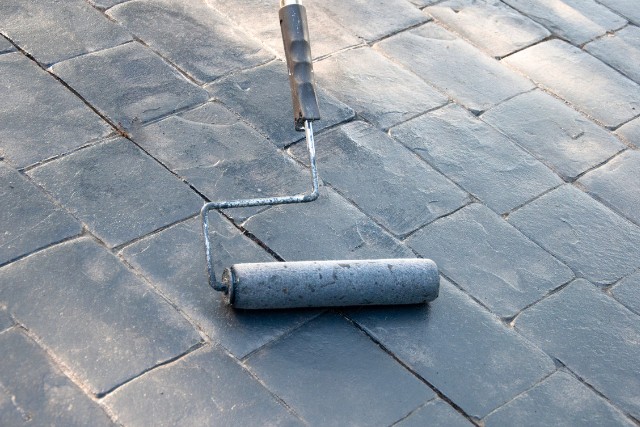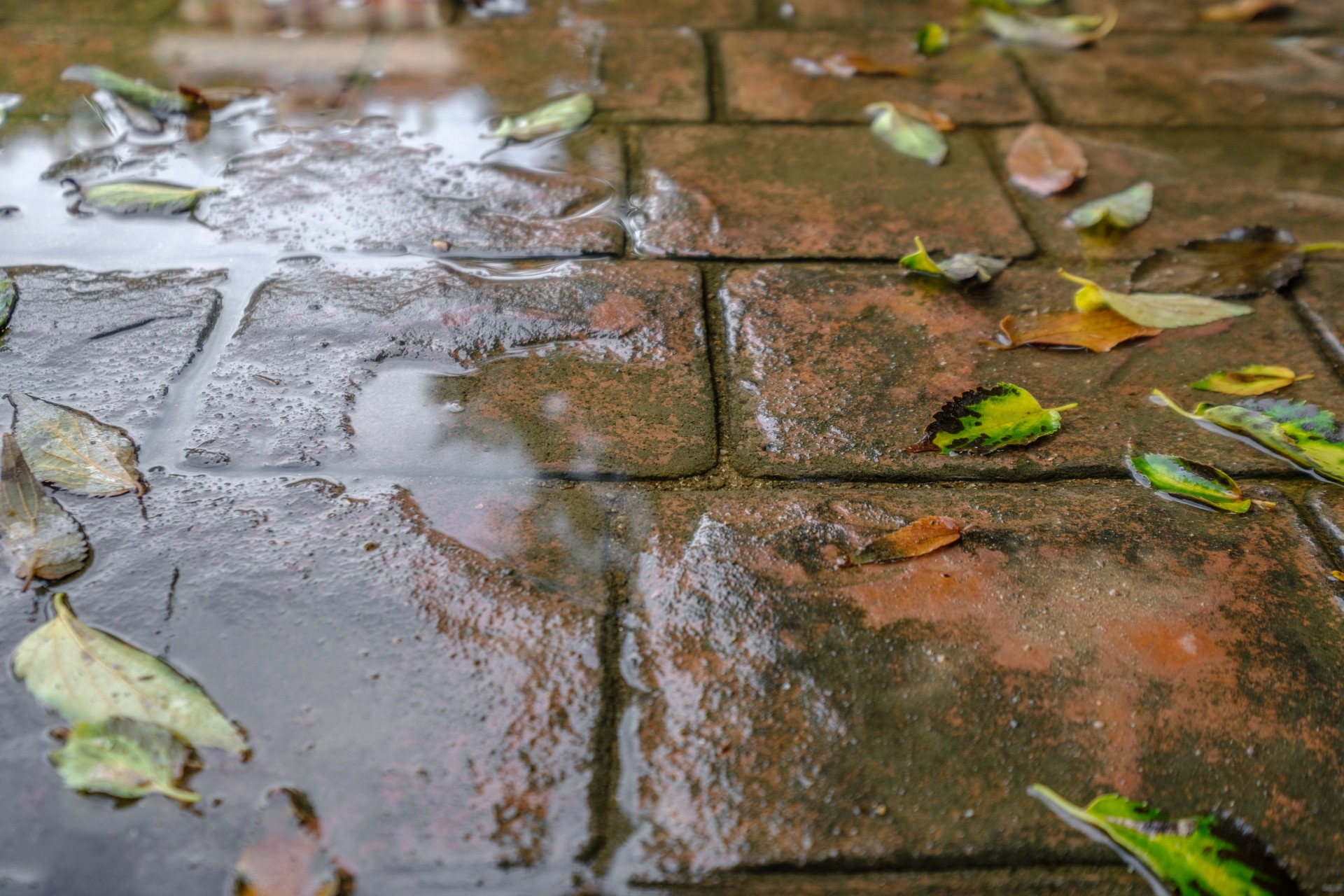Strategies to make stamped concrete less slippery include:
- Choosing a deeply and densely textured design.
- Use finishing techniques that add surface roughness.
- Select penetrating or anti-slip sealers.
- Add non-slip additives to the sealer before or during application.
- Use grit paint.
- Physically roughen the surface.
Techniques To Use Before Installation
Laying the groundwork for a slip-resistant surface ideally begins before the stamping process. The following techniques applied during the installation phase set the foundation for a safer outdoor space.
Select a Highly Textured Design
Stamped concrete offers many design options, and opting for a deeply and densely textured pattern can significantly enhance slip resistance.
Choose patterns that mimic natural textures, like stone or slate, as these tend to have inherent slip-resistant qualities.
Rock Salt Finishing
Rock salt finishing is a technique that not only adds visual appeal to stamped concrete but also contributes to slip resistance.
After the concrete is stamped, rock salt is applied to the surface. As the salt dissolves, it leaves behind small pits and indentations.
These textural variations not only create a visually interesting surface but also provide additional traction.
Choose an Aggregate Finish
Aggregates are materials like crushed stones, gravel, or sand that are mixed into the concrete before it’s poured.
When the concrete is stamped, the aggregates are exposed on the surface, creating a textured finish.
This not only provides visual interest but also serves a functional purpose by offering a rougher surface that improves traction.
Float Rather Than Trowel Before Stamping
The method of finishing the surface before stamping plays a crucial role in determining its slip resistance. Opting to float the concrete rather than trowel it before stamping is a key decision in this regard.
Floating involves using a flat tool to level and smooth the surface without creating a glossy finish. This leaves a slightly porous and textured surface that enhances grip.
In contrast, troweling creates a smoother, potentially slippery surface.
Broadcast Color Hardener Before Stamping
Color hardeners are powder additives that bring color to stamped concrete while improving its durability and texture.
Broadcasting color hardener before stamping involves evenly spreading the powder over the surface. This not only adds color but also introduces fine particles that enhance the concrete’s texture.
The hardened layer created by the color hardener increases the overall durability of the surface while providing additional traction.
Techniques To Use After Installation
Once the stamped concrete is in place, there are additional measures you can take to further bolster its slip resistance.
Post-installation techniques focus on sealers and additives that not only protect the surface but also enhance its grip.

Only Apply a Thin Layer of Sealer
Sealing stamped concrete is a common practice to protect it from the elements and enhance its longevity. However, when it comes to slip resistance, the application technique matters.
Opt for applying a thin layer of sealer rather than a thick coat. A thin layer maintains the textured surface created during installation, preserving its slip-resistant qualities.
Thick layers, on the other hand, can create a smoother surface, potentially reducing traction.
Use a Penetrating Sealer Instead of a Glossy Film-Forming Sealer
The type of sealer chosen greatly influences the slip resistance of stamped concrete. Opting for a penetrating sealer, as opposed to a glossy film-forming sealer, is a strategic choice.
Penetrating sealers are designed to be absorbed into the concrete, forming a protective barrier without altering the surface appearance and structure.
This helps maintain the textured finish created during installation, ensuring that the slip-resistant qualities of the stamped concrete are not compromised.
In contrast, glossy film-forming sealers can create a smooth surface, potentially diminishing traction significantly.
Use an Anti-Slip Sealer
For an added layer of slip resistance, consider using a specially formulated anti-slip sealer.
These sealers are designed with additives that enhance traction, providing an extra level of safety.
Anti-slip sealers typically contain particles like silica or other aggregates that create a rougher surface texture.
Mix a Non-Slip Additive With Sealer Before Application
Enhancing slip resistance can be achieved by thoroughly mixing a non-slip additive with your sealer before applying it.
These additives come in various forms, including polymer grit and silica sand. When evenly distributed within the sealer, they create a textured surface that improves traction.
Broadcast Non-Slip Additives on Top of Wet Sealer
Another effective post-installation technique involves broadcasting non-slip additives, such as polymer grit or silica sand, directly onto the wet sealer.
This method ensures an even distribution of particles to create a textured surface as the sealer dries.
Broadcasting these additives on top of the wet sealer maximizes their bonding with the surface, enhancing slip resistance.
Grit Paint
Grit paint provides an additional layer of slip resistance while introducing a decorative element to the stamped concrete.
This specialized paint contains fine particles, such as polymer grit or aggregates, that create a textured finish.
After applying the paint, the surface not only gains enhanced traction but also showcases a customized aesthetic.
Grit paint (find it here) is a versatile option, allowing you to tailor both the safety and visual aspects of your stamped concrete, making it a practical choice for outdoor spaces that demand functionality and style.
Physically Roughen the Surface
For a more intensive approach to enhancing slip resistance, consider physically roughening the surface of the stamped concrete.
Techniques such as shot blasting, needle scaling, sandblasting, or applying acid can be employed to create a textured finish.
These methods alter the surface at a microscopic level, introducing irregularities that improve traction.
While it is a more involved process, physically roughening the surface is a comprehensive way to ensure long-lasting slip resistance, especially in areas such as driveways and patios with high foot traffic or exposure to challenging weather conditions.
Tips for Maintaining Slip Resistance Over Time
Ensuring that your stamped concrete remains slip-resistant involves ongoing care and maintenance.
Follow the essential tips below to preserve the slip-resistant qualities of your outdoor surface.
1. Regular Cleaning
Keep your stamped concrete clean by regularly sweeping or blowing away debris and dirt.
Use a mild detergent and water to clean the surface, and avoid harsh chemicals that may compromise the slip-resistant finish.
2. Avoid Abrasive Cleaners
When cleaning, steer clear of abrasive cleaners that can wear down the textured surface. Opt for gentle cleaning solutions to maintain the slip-resistant qualities of the stamped concrete.
3. Periodic Sealer Reapplication
Over time, the protective seal on stamped concrete may wear off.
Periodically reapply a thin layer of sealer to maintain both the aesthetic appeal and slip resistance. Follow the manufacturer’s recommendations for the specific sealer used.
4. Inspect and Repair
Regularly inspect the stamped concrete for any signs of damage or wear. Promptly repair any cracks or imperfections to prevent further deterioration and maintain a safe walking surface.
5. Avoid De-Icing Chemicals
In colder climates, be cautious with de-icing chemicals. Some chemicals can be harsh on stamped concrete surfaces and may compromise slip resistance.
Choose de-icing products carefully, and always follow recommended application guidelines.
6. Reapply Nonslip Additives
If you notice a reduction in slip resistance, consider reapplying nonslip additives.
This may involve mixing them with a fresh layer of sealer or broadcasting them on top of the existing surface for added traction.
Reapplication is generally recommended every 2-3 years, depending on the type of sealer used.
7. Consider Professional Maintenance
For comprehensive care, consider professional maintenance services.
Professionals can assess the condition of the stamped concrete, clean the surface, perform necessary repairs, and apply specialized treatments to ensure long-lasting slip resistance.

